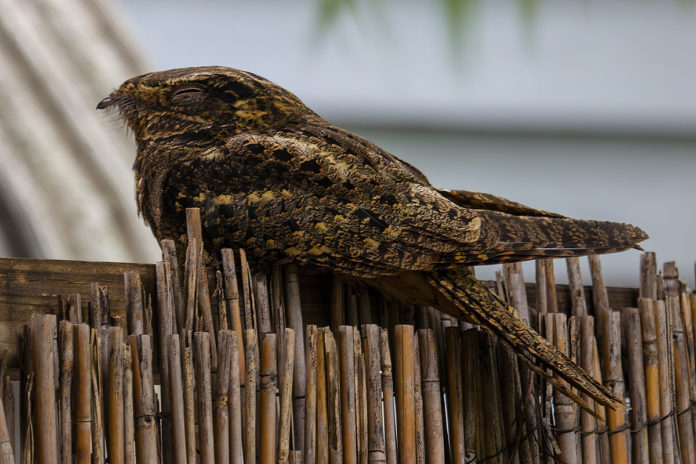The thing I like most about Chuck-will’s-widows is their confidence, which is based largely on their belief that they are invisible to you, that their presence escapes your eye. Which seems at odds with them being a largish, big-headed lump of a bird when perched. It’s not an unfounded confidence, just occasionally misplaced.
They are members of a taxonomic family known as goatsuckers, a name derived from an Aristotelian-era belief that they sneaked into barnyards late at night and sucked milk out of goats’ udders. (It was also believed this milk thievery somehow caused the goats to go blind.) Goatsuckers are primarily insectivores, though; actually, the birds were flying around the goats, scarfing up the clouds of insects that tended to follow them around.
Like other members of the goatsucker family, they have cryptic plumage, or track after track of feathers designed to confuse the brain. One account of the Chuck-will’s-widow I read, in Cornell
University’s online “Birds of the World” compendium, describes them thus: “Narrow superciliary stripe mixed Sepia Black and Buff White. Sides of head Dull Tawny Olive mixed with Hair Brown, Sepia and black. Hindcollar of feathers on nape light (ranging from white to Tawny Olive) mottled with dark…”
I’m going to stop quoting there, because I’d like people to read the rest of this column. Also, if someone was to read it aloud to a person driving a car, narcolepsy could ensue, and I don’t want to read about it in a Monroe County Sheriff’s Office press release.
In the author’s defense, there’s no real way to describe these birds without it turning into some kind of dispiriting word salad. But staring at a bird like a Chuck-will’s widow and trying to parse its parts and patterns kind of feels like that description. Their plumage is all distraction and disruption. You look at them and in most natural situations you don’t really see their shape.
It is hard to distinguish them from leaf piles or shadows on the forest floor. When they sit in trees, they tend to sit parallel to the branches, making them look more like a knot than a bird.
In theory, cryptic means the same as camouflaged, but camouflage seems like such a flimsy term compared to how well they can disappear themselves from your brain. It feels closer to a Jedi mind trick – you don’t need to make an identification; this is not a bird you’re looking at; you can go about your business; move along. Nothing to see here.
Oddly, it’s when I move along that I see them most often. As a general rule, birds don’t scare me much (unlike my editor, Mandy, who seems to have a wee bit of ornithophobia). But I don’t think any bird has ever startled me as often as Chuck-will’s-widows have. They leap up from the ground like suddenly animate goblins, then fly off, meandering through the trees in a Moscow Rules evasive pattern, in case you were somehow physically capable of tailing them.
Their wingtips actually have this very cool rust and black tiger stripe pattern, but it kind of disassembles when they’re perched with their wings folded, and is also hard to catch sight of while they fly through a shady stand of trees. It’s really only displayed during their mating rituals, which not a lot of humans have seen.
The mechanism for the whys of their behavior is pretty easy to suss out. Chuck-will’s-widows are nocturnal. They survive on insects and the occasional small bird or bat. Evolution has convinced them that their best strategy to elude danger from predators and others during the long daylight hours is to just sit tight and blend in, to become one with the branch or the forest floor.
But at a certain point, if someone gets too close, they shift to auxiliary measures – flight, both in terms of getting airborne and of fleeing. (They aren’t much for walking.)
The name, by the way, in onomatopoetic – their call has the same rhythm as saying Chuck- will’s-widow, though why the w in the name will isn’t capitalized – as it has a possessive s and by the rules of English is therefore supposed to be a proper noun – is a mystery of nomenclature.
Chucks breed in Florida, but not in the Keys. We tend to have a few around in the winter. We also get a pulse of them during migration, birds on their way south to the Caribbean and South America, or back north in the spring.
We had a small pulse come through last week. I went birding at Fort Zach and managed to flush at least six of them as I walked the berm in the hammock area alone. I don’t think any of them were more than 10 feet away when they materialized and took off.
But even if I hadn’t gone birding at Fort Zach, I would know they were around, since, as a local bird geek, I’ve had a bunch of people reach out through texts, emails and Facebook to send a photo and say, “Hey, what’s this?”
Why are so many people who aren’t prone to wandering around with binoculars, staring into bushes, seeing such an allegedly-hard-to-see bird? Because while the cryptic plumage works really well in a natural setting, it doesn’t work so well in an environment of Floridian vernacular architecture – on, say, porches, fences, tables, or the supports of eyebrow house overhangs. In fact they show up really well against the smooth surface of something like lapboard siding or two-by-eight deck boards.
At the same time, they are still confident in their superpower of invisibility, and often, unless something disturbs them, they will spend hours in the same spot in the relative open, resting, waiting for nighttime so they can take off and fly around with their mouths open, gulping down as many bugs as possible.
In 10 years of living in our house, I’ve only seen one in the backyard. But then again, who knows how often I’ve missed what I did not see.




















